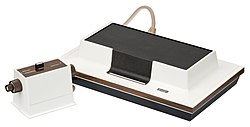Notable releases
Publications

- October – The date of the first issue of the People’s Computer Company newsletter by Dymax Inc. They print type-in listings of games and other demonstrations in the BASIC programming language, helping to spread games originally created on time-sharing networks.
Games
Arcade
- March – The second unit of Galaxy Game is placed at the Tresidder Student Union at Stanford University. This version features two fiberglass cabinets with two players each, which can be linked to create a four-player game. [16]
- October – Coin-operated games company For-Play Manufacturing in California releases Star Trek (1972) – a presumed clone of Nutting Associates’ Computer Space . [17]
- November – Atari Inc. releases their game Pong , shipping it to local distributors in the Northern California area. The game becomes a hit in the local area and launches Atari’s business.
Computer
- Empire by Reed College student Peter Langston is created for the HP2000 computer. [18]
- Louis Bloomfield of University of Illinois Champaign-Urbana creates the game Moonwar for the PLATO IV mainframe system. It becomes the most popular “big board” game on the network. [19]